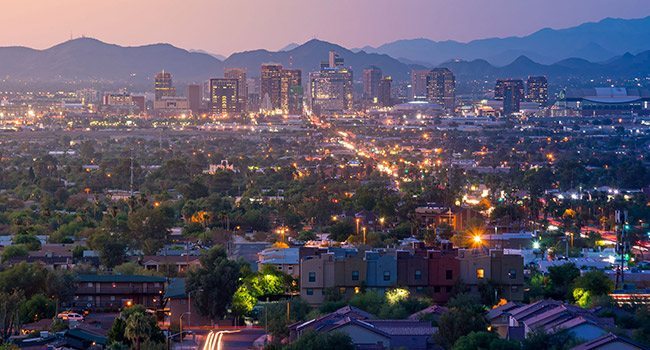For a long time, Phoenix was touted as the low-cost alternative for companies looking to relocate or expand. While Metro Phoenix still competes heavily on cost as an advantage, the Valley offers so much more value to companies – a skilled workforce, strong communities, public-private partnerships, the leading university for innovation for two years in a row and many other factors. So what does Phoenix bring to the table now when companies come to the Greater Phoenix Economic Council (GPEC) looking for a place to grow?
Who better to offer perspective than someone who has been there from the start?
“Greater Phoenix has morphed from its status of a third-tier economy in the 1980s into a highly desirable, high-value added business location in the 21st Century economy,” says Ioanna Morfessis, consultant with IO-INC. and founding president and CEO of GPEC.

Morfessis is the ideal person to summarize the big picture of an economically desirable Arizona in attracting new and growing business. Morfessis was the founding president and CEO of GPEC in 1989 and she helped develop one of the first private-public regional economic development organizations in the nation. In a single quote she has offered a 21st Century snapshot — or selfie since its 2017 — of Greater Phoenix, a once third-class passenger, making her way to the upper decks. Phoenix is no longer simply touted as the “low-cost alternative” to other markets.
Over the last few decades Phoenix has continued to rise from a cost-effective location in which to do business, to a competitive economic market composed of a skilled workforce, thriving public-private partnerships, solid educational institutions including the leading university for innovation (two years running) and much more. Rather than try to squeeze in one last analogy, let’s zoom out from the snapshot, back to the big economic picture.
Goodbye steerage – hello first-class education!
Being “low cost” was Arizona’s former dangling carrot. Maybe businesses used to feel that even though they didn’t have the best accommodations on the ship, they could make the best of the ride in Arizona’s economic climate. No more. Now, with some of the nation’s most competitive, prestigious and innovative universities, it’s first class all the way.
“Phoenix remains low cost, but of course low cost is only one of several key factors,” says Dr. Michael Crow, president of Arizona State University, which has topped U.S. News & World Report’s list of “most innovative schools” for the past two years. “The people that we talk to from ASU who are interested in locating here are looking for educational infrastructure, workforce, amenities in the community, quality of life and places for their employees and their employees’ families to be successful.”
And how do we know this? The proof is in the 73 percent of undergraduates and 53 percent of ASU graduate students who stay put after graduation.
“There has been a natural shift for Arizona, as being a low-cost outpost, to having significant market value,” says Chris Camacho, president and CEO of GPEC. “We’ve seen an increase particularly in the last three to four years with the economy improving, but even more so in our capable workforce driven by ASU.”
Joining this symbiotic relationship between education and a skilled workforce in perpetuating a healthy and resilient economy, are undoubtedly the University of Arizona, Northern Arizona University, the ever-growing Grand Canyon University and a host of community colleges.
“Our three big state universities and the emergence of Grand Canyon offer very good programs that produce a great array of BA degrees – strong finance, basic engineering, communication and tech,” says ,” says James Lundy, founding CEO of Alliance Bank Arizona and member of GPEC’s board of directors.
Public and private partnerships offer smooth sailing
While Arizona’s higher education system simultaneously attracts new blood and circulates professionals out into an ever-growing skilled workforce, there are other entities at work helping to perpetuate Arizona’s first-class economic image.
“Private-public partnerships such as GPEC, that work together with private sector leaders, elected officials and community leaders have enabled prioritization of needs,” explains Gary Naquin, executive vice president and director of corporate banking for National Bank of Arizona.
Despite what some experts would cite as negative political stigmas, such as legislative initiatives like SB1070, combined with an often overly conservative and staunch persona, Arizona’s base private-public relationships — politics aside — are strong, particularly among city leaders.
“Continuity of the leadership we’ve seen amongst the mayors has created proactive response rates in companies wanting to come into, or expand business in Arizona,” Camacho says.
“I believe Phoenix has overcome several political missteps in the last 5 years,” Naquin adds, “by investing in workforce solutions, improving infrastructure, and attracting diversity of thought and culture.”
In addition, public and private capital is increasingly distributed toward supporting entrepreneurial start-ups and emerging technologies.
Speaking of technology
As we lift the magnifying glass from Arizona’s economic algorithm, we can see how education and private-partnerships have helped to cultivate a healthy and attractive environment for new and expanding businesses — not to mention what Quarles & Brady Partner David Funkhouser, III would dutifully remind us of being fortunate to possess: “we have the weather.”
We’ve also touched upon having a solid and sensible infrastructure, in addition to other logistical perks, which we will circle back to later. For now, let’s refocus by examining three of our top thriving skilled-workforce markets, the success of which continues to attract and retain out of state business.
It’s been mentioned several times already: Arizona’s technology-related sector has become a head turner for attracting business.
“I think the tech and start-ups are dominating our current market rise,” Funkhouser says. “You have new companies like Local Motors, Carvana and Infusionsoft that are growing by leaps and bounds.”
Statistically speaking, 15,000 new tech jobs were added to the “Innovation Corridor” in Downtown Phoenix last year alone, according to a CBRE report.
“Right now we’re seeing good and positive job growth across logistics, retail and technology,” says Crow, also a member of GPEC’s board. “We also are seeing significant entrepreneurial activity, which is a hallmark of growth in the Valley.”
While technology advances, so does Greater Phoenix’s attractiveness to out-of-state companies like Gainsight, a customer relationship management software company founded in San Francisco. Phoenix is now ranked second in the nation for tech-job growth.
“What we’re not seeing yet is the critically important science and technology-based enterprise development and enterprise attraction,” Crow says. “The reason this is so important is that it lays the foundation for the economy two or three cycles down the path. This is very important relative to competitiveness going forward.”
Also grabbing national attention is financial job growth in greater Phoenix.
“We wouldn’t represent growth properly without mentioning the contributions of financial services like ADP, JP Morgan Chase and others,” Camacho says, “who have aided in dramatic growth through very significant operational services.”
“State Farm brought in (thousands of) jobs,” Lundy adds, “and other high-end call centers have contributed to financial-job growth through companies — like Amex, Discover and USAA.”
In the coming years, State Farm alone expects to have as many as 8,000 employees in the greater Phoenix area.
The third top sector to attract new and growing business: healthcare. Set your sights on billion-dollar Banner Health facilities in Tucson and Phoenix. Not to mention Abrazo Community Health Network in the West Valley. The healthcare and bioscience sectors in Greater Phoenix are projected to grow 31.9 percent over the next 10 years, which outpaces the projected national average growth of 19.5 percent.
“Arizona is outpacing the nation in biomedical and healthcare,” Camacho says.
There is another sector worthy of mention – one that has firm roots in Arizona – that has also held steady throughout the decades, but now gains momentum in attracting out-of-state labor and business.
According to Camacho, aerospace is among the top-five sector high-wage jobs.
“Growth in the last 10 years has helped us diversify, while putting intellectual capital of aerospace and defense high on the list,” Lundy says.
By growth, we can see the aerospace and defense job employment literally skyrocket in the Greater Phoenix area with companies like Orbital ATK, Honeywell, KinetX, Boeing, Iridium and Qwaltec. On the defense side, we have Luke Air Force base.
To add to the security and welfare of this growing market, are the competitive and noteworthy space programs offered through ASU and UA.
Securing our upper-deck economic future
Before we take a step back from the big picture and soak in all that makes Greater Phoenix a first-class contender for enticing new businesses, let’s think about a few more assets that sweeten up the Arizona deal.
Remember a brief mention of infrastructure? We’d be remiss in not taking a moment to pay homage to the light rail.
“I think housing is still affordable in the Central Corridor for those interested in living in the city,” Funkhouser says, “and with the light rail we are figuring out mass transportation.”
And the housing! Yes. We can be reminded here again, as an echo of Crow’s earlier comment that low cost shouldn’t necessarily take on a negative connotation. Our housing availability, cost and positioning offers an attractive livability factor, according to Camacho, and that is of great advantage to our market value.
Experts agree that in addition to housing, our retail and restaurateur reputation is expediently gaining attention and accolades.
“The most desirable assets for Phoenix are quality of life, openness to new ideas and new people, tremendous flexibility in developing and advancing new ideas, the ability to attract almost anyone here to be a part of the team, and I think a very, very positive attitude,” Crow says. “Match that with sound and positive tax policy, tremendous talent in the labor pool, and Phoenix is a great place for businesses to relocate and to start up as well to expand.”
Attraction not promotion: Team Arizona?
Our scrutiny of Arizona’s economic integrity has come to a close, but in doing so, shall we dare to ask one more question? Do we endeavor to inquire as to how we measure up to other economic markets in the nation?
Of course! We’re not afraid. We no longer wear the steerage T-shirt slogan: “Arizona: your cheap alternative.”
“Places in Texas and Colorado will remain competitive,” Camacho says, “which is why we must ensure that we have a modern economic policy to support local and outside business. GPEC has heavily invested in analytical power and are much more consultative. We’re advising companies on how to access the market.”
Bringing in new faces to a new place has the advantage of further diversification, and allows for a certain amount of flexibility.
“Phoenix continues to evolve at an increasing rate without the legacy of hundreds of years of culture, thought and infrastructure,” Funkhouser says. “In short, relative to larger markets in locations such as Texas, Colorado, California, etc., Phoenicians are more nimble and can influence change at a more rapid pace than our peers in other communities.”
The president of the most innovative university in the nation agrees.
“As the 6th largest market in the nation, the answer is ‘yes,’ we can definitely compete,” Crow adds. But his endorsement comes with a warning about issues that need to be addressed to take Greater Phoenix to the next level.
“First, we are still lagging in educational attainment overall,” Crow says. “Second, we’re lagging in the knowledge and science and technology indexes that are essential to many businesses. And, I think also importantly, we don’t tend, at the moment, to have an economic development strategy across all sectors of the economy presently here.”
Crow points that in some regions with which we compete – Denver, Salt Lake City, Austin, parts of California, Seattle – there is a deep commitment to high-levels of educational attainment, deep commitment to research and engineering in particular.
“Each of our competing regions and cities have definitively advanced engineering training education and research activities,” Crow says. “Each of these then are correlated with their competitiveness with us.”
So do we have areas to continue to improve upon? Indeed. We need to be consistent and vigilant in our economic strategy, according to Crow, if we are to keep up with our competing markets.
Bottom line: Arizona’s desirability for attracting new business, growing existing business and reinforcing an already burgeoning skilled workforce isn’t departing first-class stature anytime soon.
Perhaps we ought to close in a most apropos way, by allowing Morfessis to summarize.
“Our region offers abundant and skilled human capital; a highly energized, innovative and entrepreneurial business climate; a business-friendly state and local governments; great community colleges, ASU, and a tightly woven culture of regional cooperation, all contributing to an unbeatable asset base for business and economic growth.”










